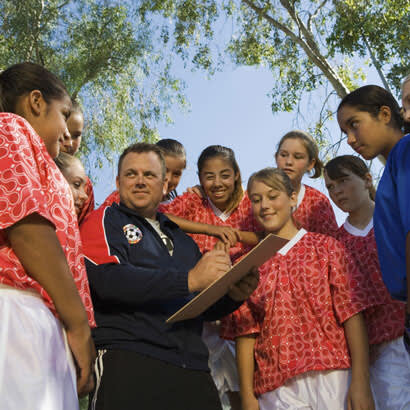When the coronavirus pandemic ends and community sports return, parks and recreation departments will have an opportunity to reclaim young athletes they’ve lost. Many experts believe that some competitive travel sports organizations – the frontrunners in youth sports over the past decade – will consolidate or cease to exist in the future.
Parks and rec departments will be asked to serve a critical need: Embrace the initial wave of kids who need a new option because parents can’t afford elite sports or don’t trust traveling. But whether parks and rec departments can capitalize on the demand is very much in doubt.
More than 90% of parks and recreation department agencies report reducing their expenses. These are the most common cost-cutting measures:
| • | Ending discretionary supplies/services purchases | 72% | |
| • | Hiring freeze | 62% | |
| • | Deferring/canceling capital projects | 54% | |
| • | Laying off part-time/seasonal staff | 51% | |
| • | Reducing energy use at facilities | 49% | |
| • | Ramping down/deferring ongoing maintenance | 34% | |
| • | Reducing outside contractors, such as landscaping | 21% | |
| • | Laying off full-time staff | 8% |
Less than six weeks into the COVID-19 shutdown, nearly half of all parks and recreation agencies have received requests to make cuts to their current fiscal year budget. Meanwhile, 31% are already making cuts to their 2020-21 budget. The typical budget cut request ranges from 10% to 19%, according to a recent survey by the National Recreation and Park Association (NRPA).
More pain is on the way. As municipalities lose more tax revenue, parks and recreation agencies are facing “pretty dire consequences from a budget perspective,” said Kristine Stratton, CEO of the NPRA, which represents more than 60,000 practitioners on the ground.
“We’re going to have to reinvent how we fund our infrastructure,” she said. “We know people will be hard-pressed to fund parks and rec, so how do we reinvent what play looks like in an economically-strained context? I think it’s an exciting opportunity that would lend itself to bring in more volunteers from communities, training up for mentors for kids, and being cognizant of youth sport sampling.”
Seven out of 10 parks and rec departments operate, maintain or manage special-purpose parks and open spaces. More than half (56%) administer or manage tournaments or outdoor sports complexes. The typical park and recreation agency annually spends $81.19 on a per capita, or per person, basis. The denser the population, the higher the per capita operating expenses.
Programming is a key method of engagement that drives the use of park and recreation facilities. When programming is associated with registration fees, it’s also the largest source of non-tax revenue for most agencies. Nationally, 87% of parks and recreation agencies offer team sports programming and 74% offer individual sports, according to the NRPA’s 2020 agency performance review.
The NRPA says that 30% of parents report their family has participated in organized sports programs offered by local parks and recreation. That equates to approximately 10 million children.
Stratton said it’s clear that parks and rec departments have lost kids not just to pay-to-play and travel sports, but also due to less-inclusionary experiences that can occur in sports. “Often times when you’re resource constrained, it forces you to be really creative and that’s an upside we could really benefit from now,” she said.
In Columbus, Ohio, the recreation and parks department is rethinking how to not only program differently, but also recruit differently. The department has a huge baseball and softball facility that stages large travel tournaments.
Most parks and recreation agencies are keeping open all of their:
| • | Trails | 91% | |
| • | Local parks | 77% | |
| • | Regional parks | 73% | |
| • | Community gardens | 70% |
Most parks and recreation agencies are keeping closed all of their:
| • | Campgrounds | 81% | |
| • | Basketball courts | 77% | |
| • | Permanent restrooms | 74% | |
| • | Tennis courts/racket sports | 62% | |
| • | Outdoor sports fields | 61% | |
| • | Beaches | 61% | |
| • | Temporary restrooms | 59% | |
| • | Dog parks | 54% |
“We now realize we’re going to have to be salespeople and not just programmers,” said Jack Castle, the city’s recreation and parks administrative coordinator. “Some of us in the past, because of our high-quality facilities and the nature of our programming, we would advertise an event and sit back and wait for teams to sign up. I don’t think we can do that anymore.”
Castle, whose department receives $2.6 million from the city, knows what’s coming due to declining tax revenue.
“I was around during the last recession,” he said. “Recreational programming might not be viewed as a need compared to other areas. That’s a major concern.”
Lessons from Great Recession
Parks and rec departments have been here before.
Between 1989 and 2003, local park and recreation spending grew by 63%. Spending grew at a slightly lower rate, 15%, between 2003 and 2008. Then came the Great Recession. The trend reversed during and after the recession, as spending plummeted by 21% from 2009 to 2013, according to a 2018 study by Penn State University and commissioned by the NRPA.
The decrease was especially noteworthy when compared to other local government services. For instance, the study found that park and recreation spending accounted for 1.9% of total local government expenditures in 2013, down from 2.2% in 2000. Of the 10 local public services analyzed, only corrections (1.8%) and libraries (0.7%) received a smaller percentage. Education (42.3%), hospitals/health (9.6%) and transportation (6.3%) received far more.
“Most notably, local government officials do not view parks and recreation as contributing to the solution of their most important issues: retaining and recruiting new businesses for their region,” the Penn State study concluded. “The impact of this perception gap is significant. While most local government officials agree parks and recreation is well worth the dollars spent on it, they openly acknowledge that they target these agencies for large budget cuts when their city, town or county faces fiscal pressures.”
The researchers said the most striking finding from the study was the sharp transformation of the workforce at local park and recreation agencies. Only 3,217 parks and recs jobs were added from 2007 to 2014 – a 0.8% increase in employment during a time when the U.S. population had grown 4.8%.
Parks and recreation agencies are providing personal protective equipment (masks, gloves, goggles, aprons) to these employees:
| • | Park rangers and police | 72% | |
| • | Maintenance staff | 58% | |
| • | Staff with childcare, shelters, food distribution | 58% | |
| • | Park ambassadors | 45% |
This happened in a period when many parks and rec jobs also shifted from full-time to part-time employment. According to the study, park and rec agencies added 45,382 part-time jobs from 2000 to 2014, while the number of full-time employees fell by 3,170 positions.
With parks and rec departments so underfunded and understaffed, quality programming dropped off in many communities. More families took their children and money to private clubs, which created travel teams at ever-earlier ages – often early in the grade school years.
“For many years, my kids played rec soccer, and you had kids picking dandelions,” said David Andreatta, a youth sports parent. “It happens. Some kids are there just for an activity to try. I get it. We moved to travel sports and it’s such a chaotic schedule. It’s a rat race. There’s no alternative in between that offers a level of play that’s competitive enough but also sane enough for kids to participate in. This is a big opportunity for recreational leagues to step up.”
How to innovate
In Appleton, Wisconsin, the parks and recreation department increased youth participation in four sports (basketball, baseball, soccer and flag football) by 70% from 2014 until early 2020. The strategy: Prioritize the inclusion of all kids, not just the best athletes, and present that approach as an asset to kids and parents, instead of being spun by competitors as a negative.
Parks and recreation leaders say these amenities and program offerings are the most likely to be part of the first phase of reopening:
| • | Currently closed restrooms | 48% | |
| • | Currently closed outdoor sports fields/courts | 43% | |
| • | Picnic areas, including grilling, shelters, pavilions | 40% | |
| • | Playgrounds | 37% | |
| • | Golf courses | 33% |
“We turned these negatives on their head as selling points and owned them,” said Nate Baldwin, Appleton’s former parks and rec director. “We have some really talented players. But inclusion means giving kids some unique ways to develop their confidence, sense of empathy, mentorship capability and leadership instead of participating in a program where you’re one of 10 clones (trained only in sport skills).”
Stratton, the NRPA’s CEO, sees opportunities for more parks and rec departments because of the evolution of modern workplaces. In the past, she said, functional skills were all that mattered for jobs.
“That thinking has really changed dramatically,” Stratton said. “Today, we look at emotional intelligence, cultural competency and critical intrapersonal skills that are important for high-functioning workplaces. I think that’s translating into how parents and community members are looking at children and what kinds of skills are really necessary, such as trauma-informed care, anti-conflict skills, and meditation to help kids navigate relationships with one another.”
Doing so will require improving the quality of coaches in some parks and rec departments. Stratton said improvements could happen through better coach training between public-private partnerships.
For example, Stratton learned from a colleague recently about a group of youth sports coaches in Portland, Maine who want to bring the trauma-informed, youth-mentoring framework into how they coach kids. The coaches recognized they can do a better job developing core skills in their players beyond how they hit a baseball or shoot a basketball.
Parks and recreation leaders anticipate these seasonal offerings to be available this summer, either in full or reduced capacity:
| • | Farmers markets | 62% | |
| • | Summer camps for general public | 21% | |
| • | Fourth of July fireworks | 19% | |
| • | Outdoor pools | 15% | |
| • | Splash pads/spray parks | 11% | |
| • | 5K races, other running/walking events | 10% | |
| • | Festivals, concerts, outdoor movies | 10% | |
| • | Sports leagues | 8% |
Infrastructure is another potential opportunity, if it’s thought through creatively. A recent survey by the NRPA found that 54% of parks and rec agencies are deferring or canceling capital projects because of the pandemic.
“Let’s not just put a sports field there,” Stratton said. “Let’s make sure it’s adaptive. Let’s make sure it can revitalize a community. How can we make sure that investments solve some of our problems, like climate readiness so green spaces are embedded in these fields?”
Yet on the other side of this pandemic, less money may be there for parks and rec departments. And potentially, due to capacity and other considerations, less kids.
“Are they going to come back like they did in the past?” asked Cole Higlin, parks and recreation director in Mandan, North Dakota. “Will all 500 baseball kids come back? Will there be a financial impact for the parents? Will they feel safe putting kids in a large crowd? I’m pretty optimistic (they will) here in a place with lower populations, but no one knows until it plays out.”
Do you have a topic that you would like Project Play to explore in future COVID-19 youth sports coverage? Email Jon Solomon at jon.solomon@aspeninstitute.org.





















